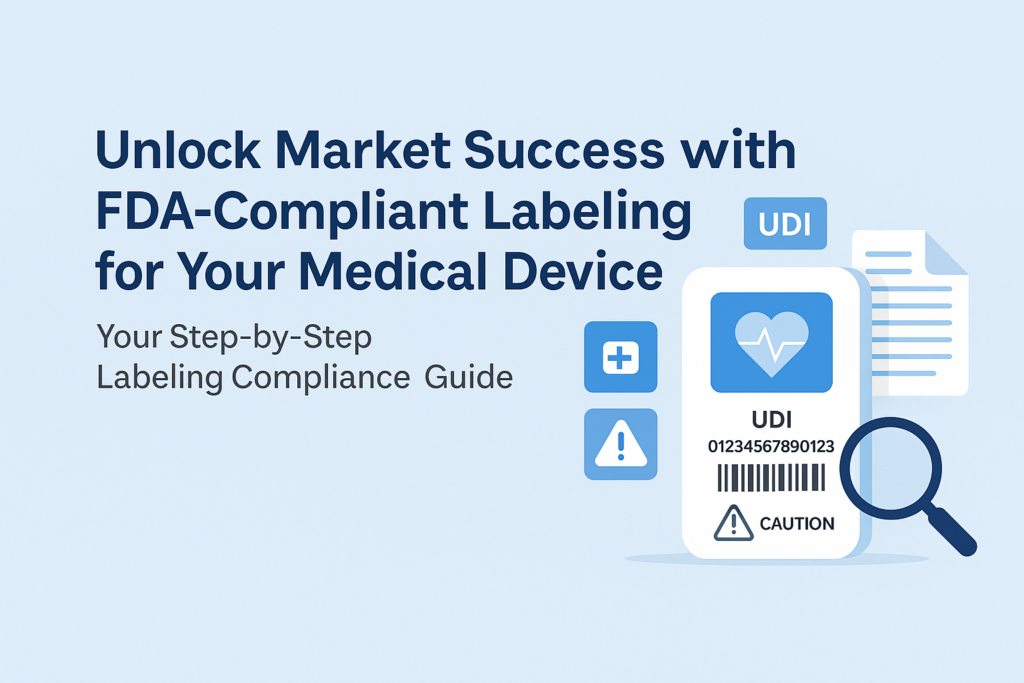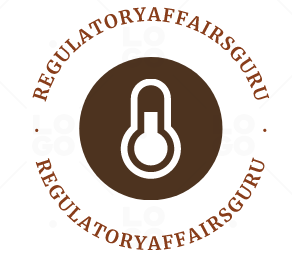Get Labeling Compliance Right, Fast

Introduction: Why Labeling Matters in Regulatory Affairs???
Labeling is not just a marketing or packaging activity; it’s also a regulation and a patient safety program.
FDA labeling ensures:
The right user uses the devices correctly and safely.
✅ Contains important information (indications, warnings, instructions).
The devices comply with 21 CFR Part 801 and are not misbranded.
✅ Supports post-market surveillance by tracing lots.
✅ Reduces liability and user errors, improving patient outcomes.
Substandard labeling can lead to:
❌ FDA Form 483 observations at inspection.
❌ 510(k) or De Novo rejection/hold.
❌ Misuse or adverse events in the field.
❌ Costly recalls or product rework.
❌Legal risk and reputational damage are also significant concerns.
Labeling is foundational for both regulatory success and patient safety.
FDA Definition of Labeling
Labeling, as defined by 21 CFR 801.109, includes
Device labels, including nameplates and molded marks, are included in the definition of labeling.
Carton/packaging labels.
Any written, printed, or graphic material that appears included with the device, including
Instructions for Use (IFU).
Quick start guides are also included.
Brochures/manuals.
Use software screens if your device requires them.
Electronic IFUs (eIFUs).
Practical Impact
✅ Any information or instructions that come with your device are labeled and are regulated by the FDA.
✅ Incongruent submission statements and labeling can cause misbranding.
Could you please clarify the FDA Regulatory Framework for Labeling?
Regulations of higher importance:
✅ 21 CFR Part 801—General labeling requirements.
✅ 21 CFR Part 830—UDI and labeling components thereof.
✅ 21 CFR Part 820.120 – Control of labeling as a QMS component.
FDA labeling requirements are the following:
✅ It includes the manufacturer’s name and address.
✅ Be in a readable and scannable UDI format.
✅ Ensure that the information is honest and not false or misleading, as providing false or misleading information constitutes misbranding.
✅ Contain adequate directions for use if not exempt (Rx devices).
✅ Contain warnings, contraindications, and precautions as necessary.
Regulatory Impact:
Misbranding under FDCA Section 502, import detentions, or recall may result from non-compliance.
Step-by-Step In-Depth Guide to FDA-Compliant Labeling
1️⃣ Categorize the Device and Determine Labeling Requirements That Apply
Why it matters:
FDA labeling requirements vary depending on
✅ Prescription (Rx) or over-the-counter (OTC) status.
✅ Implant or non-implant.
✅ Reprocessing and reuse of the device (direct marking requirements).
✅ Regulation under special device regulations (e.g., IVDs have special requirements).
Action:
Classify the device classification from the FDA Product Classification Database.
Please confirm the applicable labeling exemptions or special requirements.
Example:
Used laparoscopic instrument requirements:
✅ Direct UDI marking.
✅ IFU with sterilization and cleaning instructions.
2️⃣ Define Intended Use and Indications
Why it’s important:
Intended use and indications:
✅ Establish the basis for directions, warnings, and restrictions on your labeling.
✅ Set labeling claims.
The labeling claims must accurately reflect your specific 510(k), De Novo, or PMA clearance.
Intended use: What the device does (overall).
Indications for use include the specific condition, patient population, or clinical environment that the device is intended to treat.
Action:
✅ Review your approved submission to ensure it aligns with the intended use and indications that have been cleared.
✅ Avoid “off-label” claims, not your clearance.
Example:
Intended Use: Non-invasive measurement of blood oxygen saturation.
Indications: Pediatric and adult home and hospital monitoring.
3️⃣ Design Label Content
Minimum requirements for FDA compliance:
✅ Device name and model number.
✅ The name and address of the manufacturer.
✅ Description of intended use/indications if sufficient space and suitable.
✅ Warnings, precautions, and contraindications.
✅ Storage and handling information.
✅ UDI (machine-readable and human-readable barcode or RFID).
✅ Lot number, serial number, and expiration date where necessary.
Action:
✅ High-contrast color and legible font.
✅ Inspect label designs for obstruction of information.
Example:
A label for a wearable ECG monitor may include the following information:
“Model: ECG-Wear-01”
“Manufacturer: HealthTech Devices Inc., 1234 Street, CA, USA”
UDI: 01234567890123 (under the barcode).
“Caution: Federal law restricts this device to sale by or on the order of a physician.”
4️⃣ Create Instructions for Use (IFU)
Why it’s important:
The IFU includes instructions for safe and effective use and is part of your labeling.
Must include:
✅ Device description.
✅ Purpose and use indications.
✅ Step-by-step instructions for use.
✅ Inclusive diagrams/images to aid understanding in a clear format.
✅ Warnings and precautions statements.
✅ Cleaning/sterilizing instructions, where appropriate.
✅ Troubleshooting section.
✅ Manufacturer contact details to report adverse events.
Rx devices shall contain the following:
“Caution: Federal law restricts this device to sale by or on the order of a physician.”
Action:
✅ Place the IFU in clear, easy-to-understand language for the target users (patients or clinicians).
✅ Pilot test IFUs on patients to confirm readability during validation studies.
5️⃣ Translate (If Necessary)
Why it matters:
The FDA requires English labeling for US market distribution, but if global distribution is planned:
✅ EU MDR requires labeling and IFUs in official EU languages based on the sales country.
✅ Most global markets need localized labeling.
Action:
✅ Use professional medical translation services.
✅ Review translations with native language-speaking clinical specialists.
✅ Regulate translations within your QMS by document control procedures.
6️⃣ Label Design and Format Confirmation
Why it is essential:
Poorly designed tags:
❌ Cause improper use or misuse.
❌ Cause the barcode to fail to read.
❌ Bend readability specifications.
What to do:
✅ Verify font size, contrast, and ruggedness under anticipated use conditions.
✅ Verify barcode readability with anticipated scanners and under environmental stress (moisture, temperature).
✅ Verify adhesive performance on device surfaces.
7️⃣ Labeling Control in Your QMS
As per 21 CFR 820.120:
✅ Verification of label accuracy before release.
✅ Control of obsolete labels to prevent incorrect use.
✅ Label activity and inspection reports.
Action:
✅ Establish control of labeling processes in your QMS.
✅ Maintain label master copies in your DMR (Device Master Record).
✅ Educate manufacturing staff in the process of label application and verification.
8️⃣ eIFUs (Electronic IFUs)
Why it is important
eIFUs can reduce packaging size and expense and provide compliance where allowed.
The FDA allows eIFUs on specific devices, while the EU MDR allows eIFUs on professional-use devices subject to conditions.
Action:
✅ Confirm qualifications for eIFUs in applicable regulations.
✅ Ensure access to eIFUs is easy and predictable (QR code, websites).
✅ Perform risk analysis to provide safety and usability.
⚠️ Typical Errors to Steer Clear Of
❌ Making claims beyond your cleared indications.
❌ Absence of required warnings or contraindications.
❌ Inconsistent labeling with your submission to the regulatory agency.
❌ Substandard barcodes or UDI omission.
❌ Posting of non-approved label types or outdated templates.
❌ Including cleaning/sterilization instructions for reusable devices.
???? Best Practices for FDA-Compliant Labeling
✅ Build labels early in your design phase and allow them to age.
✅ Report claims on labels entirely consistent with cleared indications.
✅ Upload labels and IFUs to the QMS document control system.
✅ Test IFUs and test labels during usability testing when possible.
✅ Continuously evaluate labels post-market to address field feedback.
✅ Coordinate US and EU MDR/IVDR readiness labeling for scalability.
???? Real-World Case Example
One wearables firm had a 510(k) hold for:
❌ Including “diagnostic” in labeling on a device that was not cleared as diagnostic.
❌ Lacking “Rx Only” language for a prescription product.
❌ Lacking UDI on the package labels.
Action Taken
✅ Corrected claim labeling claims to be compliant with indications cleared.
✅ met the required FDA disclaimers and UDI.
✅ Legally compliant IFU re-drafted for clarity.
Outcome: Cleared 510(k), successful US launch, and EU MDR readiness filing.
Compliant Labeling System Benefits
✅ Enhanced FDA clearance and inspection readiness.
✅ Reduced legal risk of labeling or misuse.
✅ Enhanced user satisfaction and reduced training burden.
✅ Easier recalls and post-market activities.
✅ Enhanced brand trust and market acceptance.
📚 References
1️⃣ FDA Device Labeling: https://www.fda.gov/medical-devices/overview-device-regulation/device-labeling
2️⃣ 21 CFR Part 801: Labeling Requirements https://www.ecfr.gov/current/title-21/chapter-I/subchapter-H/part-801
3️⃣ 21 CFR Part 820.120: Labeling Control https://www.ecfr.gov/current/title-21/chapter-I/subchapter-H/part-820/section-820.120
4️⃣ FDA UDI System: https://www.fda.gov/medical-devices/unique-device-identification-system-udi-system
5️⃣ FDA Labeling Guidance: https://www.fda.gov/media/116630/download
6️⃣ ISO 15223-1:2021 – Medical Device Symbols: DOI 10.3403/30255656
7️⃣ EU MDR Labeling Requirements (2021): DOI 10.2873/70064
